
The Metropolitan Railway was a passenger and goods railway that served London from 1863 to 1933, its main line heading north-west from the capital's financial heart in the City to what were to become the Middlesex suburbs. Its first line connected the main-line railway termini at Paddington, Euston, and King's Cross to the City. The first section was built beneath the New Road using cut-and-cover between Paddington and King's Cross and in tunnel and cuttings beside Farringdon Road from King's Cross to near Smithfield, near the City. It opened to the public on 10 January 1863 with gas-lit wooden carriages hauled by steam locomotives, the world's first passenger-carrying designated underground railway.

The Mersey Railway was the passenger railway connecting the communities of Liverpool, Birkenhead, England. It is currently a part of the Merseyrail network. It was extended further into the Wirral Peninsula, which lies on the opposite bank of the River Mersey to Liverpool. Both sides of the river were connected via the Mersey Railway Tunnel. The railway opened in 1886 with four stations using steam locomotives hauling unheated wooden carriages; in the next six years the line was extended with the opening of three more stations. Using the first tunnel under the Mersey, the line is the world's oldest underground railway outside London.
Diesel locomotives have seen limited use on the London Underground, largely because exhaust gases cannot be discharged when the vehicles are working in tunnels. A prototype diesel engine numbered DEL120 was built in 1939 from two 1915 stock motor cars, which was expected to be part of a batch of ten, but experience with battery locomotives showed that these were a better alternative. Three 0-6-0 diesels (DL81-DL83) were obtained in 1971, to replace the last steam engines, but were too short to operate the signalling system, and too heavy for some of the bridges. In 1996, fourteen diesels were supplied by Schöma of Germany, which were used during the construction of the Jubilee line tunnels. They were fitted with exhaust scrubbers, to enable them to work in the tunnels. To speed up track renewals on the subsurface lines, Class 66 locomotives have been hired in since 2006 to handle permanent way trains, but again suffer from being too heavy for some of the bridges. Because they are not fitted with tripcock safety devices, and pull trains much longer than the signalling system is designed for, they are restricted to slow speed running.
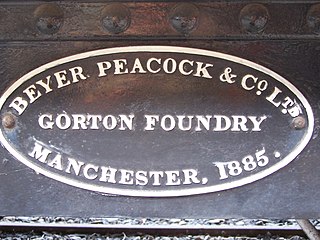
Beyer, Peacock and Company was an English general engineering company and railway locomotive manufacturer with a factory in Openshaw, Manchester. Charles Beyer, Richard Peacock and Henry Robertson founded the company in 1854. The company closed its railway operations in the early 1960s. It retained its stock market listing until 1976, when it was bought and absorbed by National Chemical Industries of Saudi Arabia.
The Highland Railway O Class locomotives were built as 2-4-0T tank engines, but were soon rebuilt as 4-4-0Ts. They were designed by David Jones for Scottish Railway companies and three were built at the company's Lochgorm Works in 1878 and 1879.

The Metropolitan Railway E Class is a class of 0-4-4T steam locomotives. A total of seven locomotives were built between 1896 and 1901 for the Metropolitan Railway: three by the railway at their Neasden Works and four by Hawthorn Leslie and Company in Newcastle upon Tyne.

The Caledonian Railway 498 Class was a class of 0-6-0Ts built for dock shunting. They were designed by John F. McIntosh for the Caledonian Railway (CR) and introduced in 1911. Twenty-three were built. They passed to the London, Midland and Scottish Railway (LMS) in 1923 and to British Railways (BR) in 1948. Their numbers are shown in the table below.
The Metropolitan Railway H Class consisted of eight 4-4-4T steam locomotives, numbered 103 to 110. They were built by Kerr, Stuart & Co of Stoke on Trent in 1920 at a cost of £11,575 each. A "notable addition" to the Metropolitan Railway, these locomotives were purchased for the express passenger trains on the mainline between Harrow —the change point from electric locomotives—and Aylesbury or Verney Junction.

The Metropolitan Railway K Class consisted of six 2-6-4T steam locomotives, numbered 111 to 116.
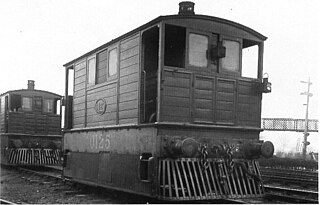
The GER Class G15 was a class of ten 0-4-0T steam tram locomotives designed by Thomas William Worsdell for the British Great Eastern Railway. Six passed to the London and North Eastern Railway (LNER) at the 1923 grouping, and received the LNER classification Y6.
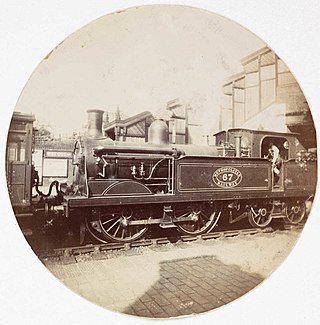
The Metropolitan Railway C class was a group of four 0-4-4T steam tank locomotives built in 1891 by Neilson and Company. They were to a design by James Stirling, originally the Q class of the South Eastern Railway, and were fitted with condensing apparatus for working in tunnels.
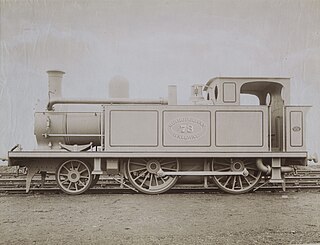
The Metropolitan Railway D Class was a group of six 2-4-0T locomotives built for the Metropolitan Railway in 1894-1895 by Sharp, Stewart and Company.

The New South Wales Z12 class was a class of 4-4-0 steam locomotives operated by the New South Wales Government Railways of Australia.
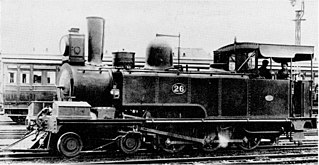
The South African Railways Class C 4-6-0T of 1879 was a steam locomotive from the pre-Union era in the Colony of Natal.
District Railway steam locomotives were used on London's Metropolitan District Railway. When in 1871 the railway needed its own locomotives, they ordered twenty four condensing steam locomotives from Beyer Peacock similar to the A Class locomotives the Metropolitan Railway was using on the route. As they were intended for an underground railway, the locomotives did not have cabs, but had a weatherboard with a bent-back top and the back plate of the bunker was raised to provide protection when running bunker first.
The L&YR Class 2 (Aspinall) was a class of 4-4-0 steam locomotives of the Lancashire and Yorkshire Railway.

The SER Q class was a class of 0-4-4T steam locomotives of the South Eastern Railway. The class was designed by James Stirling and introduced in 1881.

The first Metropolitan Railway steam locomotives were ordered in 1864 for the Metropolitan Railway, to replace the Great Western Railway locomotive that had opened their first line the previous year. A total of 116 locomotives were built, of which two survive in preservation.

The London Underground opened in 1863 with gas-lit wooden carriages hauled by steam locomotives. The Metropolitan and District railways both used carriages exclusively until they electrified in the early 20th century. The District railway replaced all its carriages for electric multiple units, whereas the Metropolitan still used carriages on the outer suburban routes where an electric locomotive at the Baker Street end was exchanged for a steam locomotive en route.

The LNWR 4ft 6in Tank was a class of 220 passenger 2-4-2T locomotives manufactured by the London and North Western Railway in their Crewe Works between 1879 and 1898. The "4ft 6in" in the title referred to the diameter of the driving wheels – although the stated dimension was for the wheel centres – the nominal diameter including the tyres was 4 ft 8+1⁄2 in (1,435 mm).

















